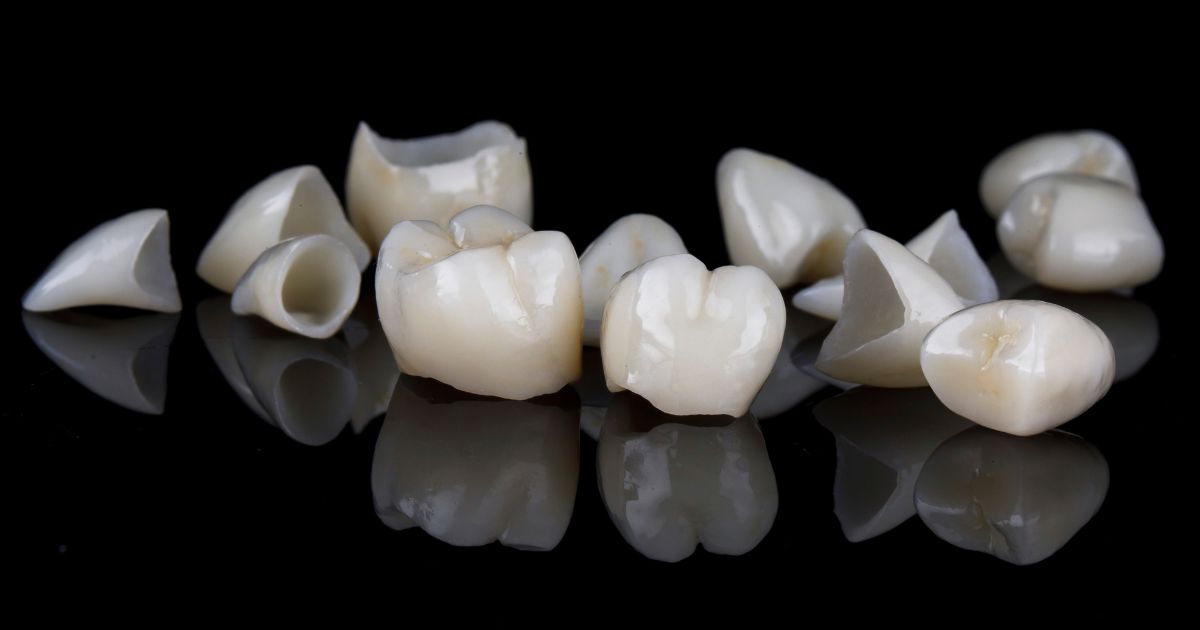
How Do Veneers Work on Teeth? An Overview
Veneers, a popular cosmetic dentistry solution, play a pivotal role in transforming smiles and boosting confidence. These thin shells, typically made of porcelain or composite resin, are custom-designed to cover the front surface of teeth, offering an effective remedy for a range of dental imperfections, including enamel defects and discoloration.
How do veneers work on teeth? They provide a sought-after option for those seeking a radiant and flawless smile, addressing various cosmetic concerns with precision and durability.
Understanding Veneers: How Do Veneers Work on Teeth?
Veneers are thin, custom-made shells crafted from durable materials like porcelain or resin. They are designed to cover the front surface of teeth, providing an effective solution for various cosmetic dental concerns. The primary purpose of veneers is to enhance the appearance of teeth by improving their color, shape, size, or length.
- Custom-made shells: Veneers are tailor-made for each individual, ensuring a precise fit.
- Cosmetic enhancement: Veneers address aesthetic concerns, such as discoloration or irregular tooth shape.
- Versatile applications: Veneers can be used to treat a range of cosmetic issues, providing a comprehensive dental solution.
- Durable materials: Crafted from porcelain or resin, veneers offer long-lasting results.
- Minimal tooth alteration: Unlike some dental procedures, veneers require minimal removal of natural tooth structure.
- Stain-resistant properties: Veneers resist stains, contributing to a consistently vibrant smile.
Unveiling the Benefits of Veneers: Restoring Confidence and Beauty
Beyond their cosmetic appeal, veneers offer a host of benefits that extend to both appearance and self-esteem. These thin shells serve as a powerful tool for restoring confidence and beauty in one’s smile.
| Benefit | Description |
| Confidence Boost | Significantly boosts self-confidence by transforming teeth. |
| Natural Look and Feel | Mimics the natural look and feel of teeth for a seamless blend. |
| Stain Resistance | Resistant to staining, ensuring a long-lasting, radiant smile. |
| Quick Recovery | Involves minimal discomfort and a quick recovery period. |
| Improved Durability | Enhances the strength and resilience of treated teeth. |
| Customizable Aesthetics | Allows patients to choose color, shape, and size for a personalized result. |
The Ideal Candidates for Veneer Treatment: Addressing Enamel Defects and Discoloration
Veneers are an excellent option for individuals facing enamel defects or persistent tooth discoloration that cannot be effectively addressed through traditional whitening methods. Identifying the ideal candidates for veneer treatment involves considering specific dental concerns.
| Candidate Criteria | Description |
| Enamel Defects | Suitable for those with enamel defects. |
| Tooth Discoloration | Effective for stubborn discoloration. |
| Minor Misalignments | Improves the appearance of slightly misaligned teeth. |
| Healthy Teeth and Gums | Ideal candidates have good oral health. |
| Adequate Tooth Structure | Requires sufficient natural tooth structure. |
| Commitment to Oral Hygiene | Candidates must commit to maintaining good oral hygiene |
Preparing for Veneer Placement: A Consultation with Your Dental Professional
Before the veneer application process begins, a thorough consultation with a dental professional is crucial. This step involves assessing the patient’s oral health, discussing expectations, and planning for the transformation of their smile.
- Comprehensive examination: Dental professionals conduct a thorough examination to assess the patient’s oral health and determine the suitability for veneers.
- Digital impressions: Advanced technology, such as digital impressions, aids in creating precise and customized veneers for optimal results.
- Treatment planning: A detailed treatment plan is developed, outlining the steps involved in the veneer application process.
- Communication of expectations: During the consultation, patients have the opportunity to communicate their expectations and goals for the veneer treatment.
- Cost and timeline discussion: The financial aspects and expected timeline of the veneer treatment are discussed to ensure transparency and informed decision-making.
- Preparing natural teeth: In some cases, a minimal amount of enamel may be removed to accommodate the veneers and achieve the desired result.
The Veneer Application Process: A Step-by-Step Guide to a Transformed Smile
The veneer application process involves several precise steps to ensure the optimal fit, function, and aesthetics of the final result. Understanding this step-by-step guide provides insight into the transformation that takes place during the application of veneers.
| Application Steps | Description |
| Tooth Preparation | Removal of a small amount of enamel for veneer placement. |
| Impression Creation | Detailed impressions taken for custom-made veneers. |
| Temporary Veneers | Placement of temporary veneers while permanent ones are crafted. |
| Veneer Bonding | Careful bonding of custom veneers using dental adhesive. |
| Bite Adjustment | Assessment and adjustment of the bite for proper alignment. |
| Final Polishing | Polishing veneers to create a smooth and natural appearance. |
Post-Veneer Care: Maintaining Your Radiant Smile with Proper Hygiene
After the veneer application process is complete, maintaining proper oral hygiene is crucial to ensure the longevity and optimal appearance of the veneers. A consistent and effective care routine contributes to a radiant smile that lasts.
- Regular dental check-ups: Routine dental visits allow professionals to monitor the condition of the veneers and address any issues promptly.
- Gentle brushing and flossing: Adopting a gentle brushing and flossing technique helps preserve the veneers and maintain overall oral health.
- Avoiding excessive force: Refraining from habits like nail-biting and using teeth as tools prevents unnecessary stress on the veneers.
- Non-abrasive toothpaste: Using a non-abrasive toothpaste preserves the integrity of the veneers and prevents scratching or damage.
- Mouthguard use: For individuals who grind their teeth at night, wearing a custom mouthguard protects both natural teeth and veneers from potential damage.
- Stain-conscious habits: Limiting the consumption of stain-causing substances, such as coffee and tobacco, helps preserve the brightness of veneers.
Veneers vs. Crowns: Understanding the Differences in Treatment Options
While both veneers and crowns serve cosmetic and functional purposes, understanding the differences between these two treatments is essential for making informed decisions about dental care.
| Treatment Comparison | Description |
| Coverage Area | Veneers cover the front surface, while crowns encase the entire tooth. |
| Enamel Removal | Veneers require minimal enamel removal, preserving more natural tooth. |
| Indications for Use | Veneers for cosmetic enhancements; crowns for significant damage. |
| Tooth Preservation | Veneers are more conservative, preserving more natural tooth. |
| Treatment Timeline | Veneers have a shorter treatment timeline for cosmetic improvements. |
| Cost Considerations | Veneers are generally more cost-effective for cosmetic enhancements. |
Embracing a Brighter Future with Veneers: Enhancing Your Smile and Overall Well-being
The decision to undergo veneer treatment goes beyond aesthetic considerations; it can positively impact overall well-being by boosting confidence and promoting a healthier self-image.
| Positive Impact | Description |
| Psychological Benefits | A transformed smile contributes to improved self-esteem. |
| Social Confidence | Enhanced aesthetics lead to increased confidence in social interactions. |
| Long-Lasting Results | Veneers offer a durable solution with sustained benefits. |
| Improved Oral Hygiene Habits | Commitment to maintaining veneers often improves overall oral health. |
| Comprehensive Transformation | Veneers address multiple concerns for a total smile makeover. |
| Customized Results | The customizable nature of veneers ensures a personalized and brighter future. |
Comprehending how veneers work on teeth is pivotal for those seeking to address various cosmetic dental concerns. Whether dealing with enamel defects or tooth discoloration, veneers emerge as a versatile and effective solution, offering not just cosmetic improvements but also a significant boost to confidence and overall well-being. As individuals consider the transformative power of veneers, it’s crucial to explore the customizable nature of this treatment to achieve desired aesthetic goals.
Moreover, for those seeking the best veneers in Dubai, understanding the intricacies of the veneer application process becomes even more critical. This burgeoning hub of cosmetic dentistry offers a range of clinics, each vying to provide the highest quality of care. Considering the specific needs and expectations, individuals can make informed choices when selecting the right clinic for their veneer treatment.
With proper consultation, meticulous preparation, and dedicated post-treatment care, veneers can stand as a beacon of a brighter future, offering not just a radiant smile but also contributing to improved self-esteem and mental well-being. So, whether pondering on “how do veneers work on teeth” or searching for the “best veneer in Dubai,” the journey to an enhanced smile and confidence begins with understanding the transformative potential of veneers.
FAQs
Are veneers suitable for everyone?
Veneers are ideal for individuals with enamel defects, tooth discoloration, and minor misalignments, provided they have good oral health and adequate tooth structure.
How long does the veneer application process take?
The veneer application process typically involves tooth preparation, impression creation, bonding, and final polishing, taking a few weeks from consultation to final placement.
What is the main difference between veneers and crowns?
Veneers cover the front surface of teeth for cosmetic enhancements, while crowns encase the entire tooth, offering structural support and addressing more extensive damage.
Can veneers be whitened or stained?
Veneers are resistant to staining; however, they do not respond to teeth whitening treatments. Maintaining stain-conscious habits and good oral hygiene preserves their brightness.
How long do veneers last?
With proper care and maintenance, veneers can last for many years, providing durable and long-lasting results for individuals seeking a transformed smile.
Is the veneer application process reversible?
While the tooth preparation step involves minimal enamel removal, the veneer application process is generally irreversible. It's essential to carefully consider the decision before proceeding.
Table of Contents



